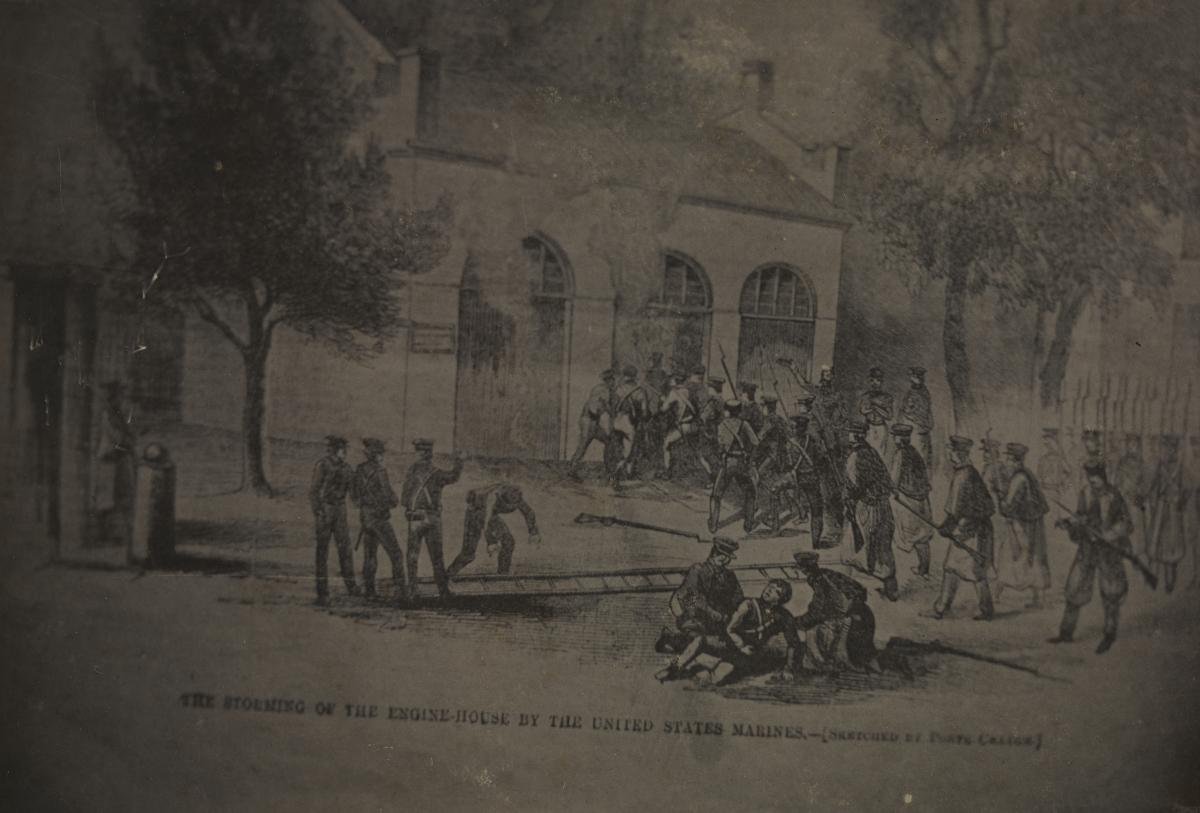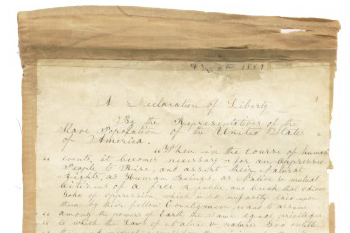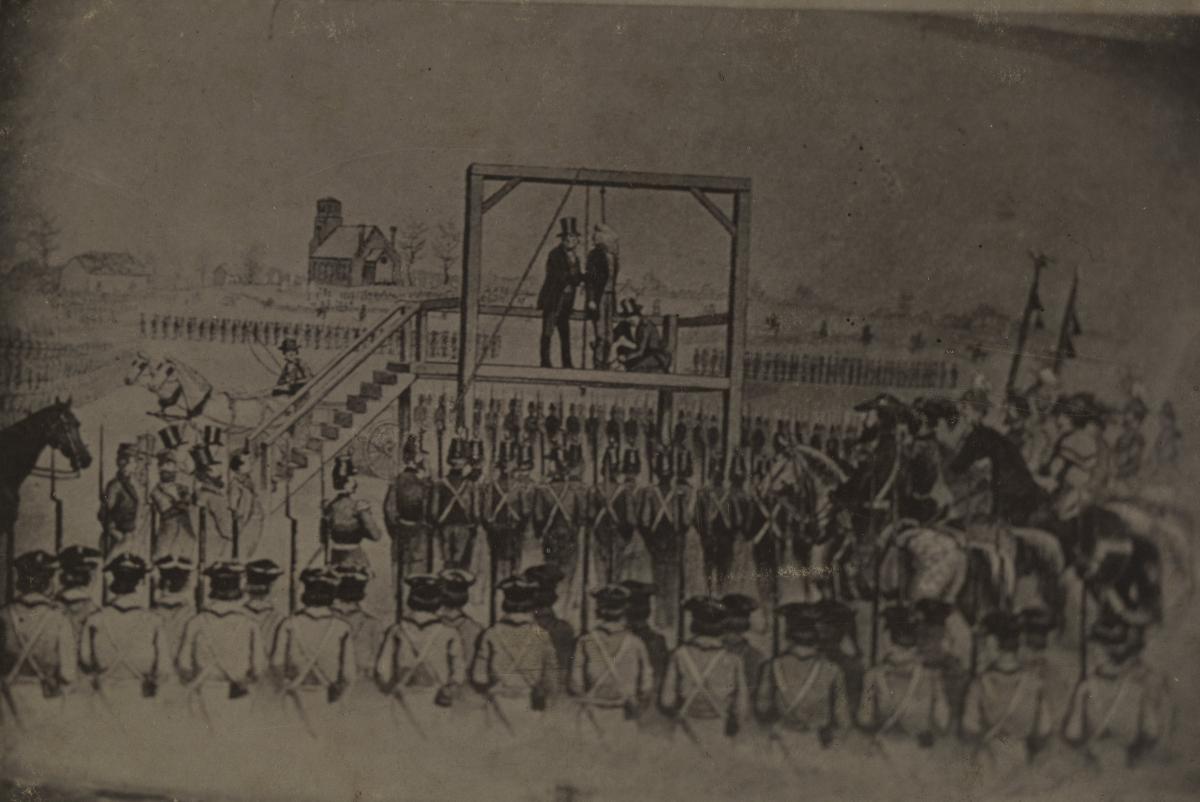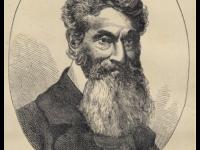Posted on behalf of Jacob Roberts, an intern who worked on the Preserving American Freedom Project
While working on the Preserving American Freedom Project, it is easy to take for granted how many one-of-a-kind documents have been preserved at the Historical Society of Pennsylvania. In many cases, these papers could have just as easily been lost or destroyed by those who did not see historical value in them. The fact that so many survived is nothing short of miraculous.
One such document I have come across during my internship is John Brown's "A Declaration of Liberty, By the Representatives of the Slave Population of the United States of America." Brown is best known for his raid on the armory at Harpers Ferry in 1859 where he hoped to incite a slave rebellion and end the institution of slavery in America. Although Brown and his followers were able to infiltrate the armory and free a few slaves, they were quickly captured by U.S. troops, convicted of treason, and executed. After the battle, federal soldiers found a cache of papers, letters, and maps at the Kennedy Farmhouse just outside Harpers Ferry. Brown's group had hidden there for months while planning the attack and left a paper trail of their preparation. Among the many documents recovered was the Declaration of Liberty, essentially a manifesto of Brown's movement. The Declaration borrowed language from the Declaration of Independence, using its similarities to exhibit the hypocrisy of the founding fathers, who expounded freedom for America while slavery still ran rampant.

US Marines storming Harpers Ferry
As I conducted this research, I started to wonder how John Brown's Declaration of Liberty survived through all the chaos. Not only was it acquired in the middle of a military operation, it was also used as evidence in Brown’s trial. It must have been passed between many different people in a very short time. Looking at the relic today, it is in amazingly good shape. The Declaration, handwritten by Owen Brown, John Brown’s son, is glued to a long cloth and rolled around a wooden shaft, not unlike a scroll. Based on early descriptions of the document, the only thing missing is a piece of string looped through one end. As I delved deeper into the story of Harpers Ferry, I learned what might have happened to the Declaration, as well as the countless letters and maps Brown had collected at the Kennedy Farmhouse.

John Brown's Declaration of Liberty
The governor of Virginia, Henry Wise, was furious when he heard about Brown's raid on the armory. Determined to prove that the attack was part of a larger Northern conspiracy to abolish slavery, he ordered Henry Hudnall (likely a lawyer-clerk) to investigate the cache of papers found at the Kennedy Farmhouse. These papers are often referred to as the "captain's carpetbag," because they belonged to John Brown (the "captain") and were originally found in a large traveling bag by soldiers. The collection of papers proved to be a treasure trove of information about Brown's activity in the years leading up to the raid, the wealthy abolitionists who funded it, and Brown's progressive vision of an alternative, free republic.

Photograph of the Kennedy Farmhouse
Hudnall transcribed the relevant documents, including the Declaration of Liberty, and sent a report back to Wise. The report revealed Brown’s plans to lead an army of freed slaves into the Appalachian Mountains where he planned to form an independent country and abolish slavery. The report also included a letter from Gerrit Smith, the notable Northern abolitionist, promising Brown $200 for his cause. This evidence of Northern collaboration sent Virginians into a panic. The state government passed down Brown’s death sentence swiftly, and in a little more than a year the disgruntled state seceded from the Union.

John Brown's execution
Even before Brown’s body was cold, the carpetbag full of incriminating papers had been broken up and sent around the country. Some documents arrived at the United States Senate where they were transcribed for a federal report. Others were collected by private citizens and donated to various historical institutions. Based on my research, it seems possible that Ferdinand J. Dreer, who was known to collect autographs and had a particular interest in the incident at Harpers Ferry, acquired the Declaration in the wake of the trial. Dreer’s entire collection of rare documents was donated to the HSP in 1890. If he had the Declaration in his possession, it would have arrived at the HSP at that time.
But the Declaration of Liberty was not the only significant document to come out of the raid on Harpers Ferry. While Brown was waiting in his cell in the weeks before his death, he exchanged countless letters with co-conspirators, family members, and people who sympathized with his cause. A large file (not to be confused with the captain’s carpetbag) of this correspondence was stored in the Library of Virginia after Brown was hung. There it sat, undisturbed in the Confederate capitol of Richmond for five years as the nation fought a devastating civil war.
In 1865, the war was ending and the librarian in Richmond learned that Union troops were closing in on the city. Recognizing the value of the Brown letters, he frantically gathered them up, scrambled to the upper floor of the library, and stuffed them into a wall panel. After the Union occupied the city and reestablished the state government, the librarian left his position without retrieving the papers. No one else knew exactly where he put them, and they became lost for nearly thirty years.
At least, that was the legend told to W. W. Scott, the new Virginia State Librarian, in 1894. Scott also understood the historic value of the Brown letters, and spent the better part of a decade searching for them. As soon as he heard the story about the papers being hidden in 1865, he went to the top gallery of the library to look for himself. Once there, he found no wall panels that any papers could have been hidden behind. Disappointed, Scott began interviewing people who had been employed by the library in 1865.
Scott found a lead in Walker Howard, an African American janitor who had worked in the library since the Civil War. Howard did not corroborate the story of the Brown papers being hidden in an upstairs wall. Instead he claimed that when the war began, the librarian had knocked a hole in a basement wall and placed them inside. Unfortunately, the hole had been sealed to protect the papers, and he could not recall where it was. Unperturbed, Scott called in brick masons to find a hollow spot in the wall. When the brick masons believed they had found one, he ordered them to knock it down. Of this adventure Scott writes, "While the excavation was going on it was as absorbing as digging for buried treasure, and it ended in the usual result."
Disappointed yet again, Scott finally gave up actively searching. He believed it was likely that Union troops had stolen the letters when they raided Richmond in 1865, and subsequently lost them. As luck would have it, Scott was conducting a meticulous inventory of the archives in 1901 to determine if certain documents had been stolen when he stumbled across a dusty envelope titled "John Brown Papers" just sitting on a shelf. Inside were most of the original letters Brown had received while awaiting his execution. If not for Scott's recognition of these important papers, they very well might have been lost forever. These letters have since been recorded on microfilm, and some of them are available at the Library of Virginia.
We may never know exactly what path the Declaration took to the HSP or where each individual letter found in the Library of Virginia ended up. The paper trail grows colder the further we look back. Nevertheless, the travails of these objects remind us of how lucky we are to have preserved anything at all from the past. And much of what we do have we owe to the obsessions of heroic librarians and collectors like Scott and Dreer.
Of course, contemporary society has a very different problem with preserving important information. Imagine a historian, one hundred years from now, trying to conduct research about your life (also try to imagine that you are as legendary as John Brown). Chances are there are very few documents that you have maintained in paper form. The majority of our information exchange happens digitally, with personal data being stored on a server in an unknown location, or in a media format that will become obsolete and incompatible with future computers. If John Brown's Declaration had been stored on the equivalent of an ancient computer punch card, it is doubtful that it would be able to tell the story of American freedom at all.

